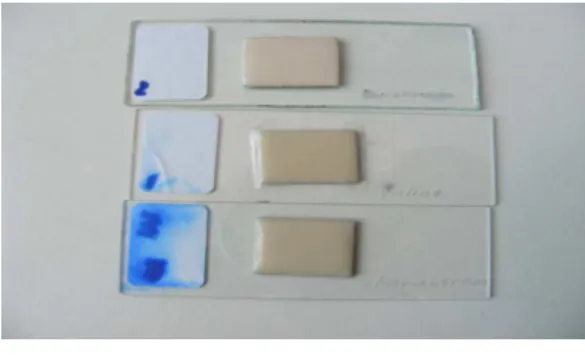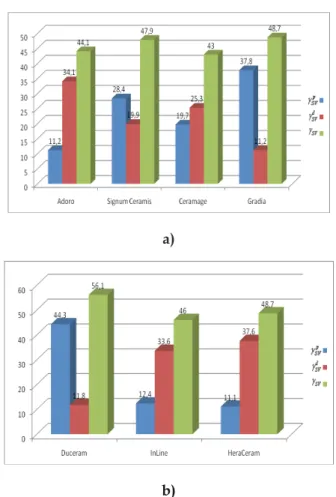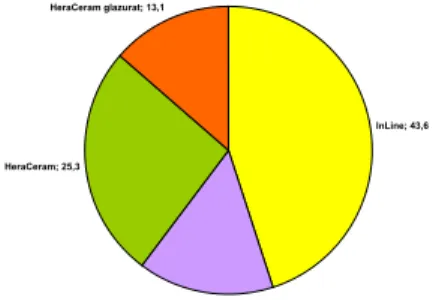International Journal of Medical Dentistry 265
STUDY OF SURFACE PHENOMENA IN MATERIALS OF PROSTHETIC RESTORATION
Abstract
As a direct consequence of their application domain – the oral cavity – dental materials are subjected to the coro-sive action of saliva, being surrounded by microorganisms, fluids and alimentary rests, which modify their surface characteristics. Concerns on the quality of the dental mate-rials explain the numeorus interdisciplinary studies, char-acterized by a close relation among various scientific domains (physics, chemistry, biology, science of biomateri-als), techniques also applied in clinical stomatology. Anal-ysis of the saliva–dental materials interface made use of ceramic surfaces, composites and artificial saliva, permit-ting to determine the main surface parameters of the mate-rials of prosthetic restoration, calculated with some physical models, starting from measurements of the con-tact angle: surface energy, its polar and dispersive compo-nents, surface rugosity, adhesion mechanic work. All composites showed low values of the adhesion mechanic work, the conclusion being that they are much more hydro-phobic than the ceramic materials. Such a property is espe-cially important from an aesthetic perspective, as the hydrophobic materials have a better colour stability in time.
Keywords: ceramics, composites, contact angle, saliva,
surface energy, rugosity.
INTRODUCTION
Knowledge on the surface energetic characteristics
of biomaterials inluences the adherence of cells, bac
-teria, the adsorption of surface plasmatic proteins, as well as the capacity of such surfaces of immobilizing certain biological species of special interest in medi -cine.
If considering the processes developed at the dental materials–biological fluid (oral medium) interface, a double effect may be observed: dis-eases generated by the materials used in stoma-tology and the failure of their utilization [1-4].
STUDY OF SURFACE PHENOMENA IN MATERIALS
OF PROSTHETIC RESTORATION
Mihaela-Păpuşa Vasiliu1, Carmen Stadoleanu2, Daniela Ivona Tomiţa3, Cristina-Mihaela Stanilă4, S.-C. Jalbă4, Nicoleta Dumitraşcu5
1. Univ. Assist., Dr., Faculty of Dental Medicine, ”Apollonia” University of Iaşi 2. Prof. Univ., Dr. Faculty of Dental Medicine, ”Apollonia” University of Iaşi 3. Lecturer, Dr., Faculty of Dental Medicine, ”Apollonia” University of Iaşi 4. Dr., Faculty of Dental Medicine, ”Apollonia” University of Iaşi
5. Prof. Univ., Dr., Faculty of Physics, ”Al. I. Cuza” University of Iaşi Contact person: Carmen Stadoleanu, e-mail:drcarsta@yahoo.com
Nowadays, specialists’ concerns are mainly oriented towards the improvement of the quality of implants and of the minimum-invasive devices for human organis m’s analysis, a higher biocom-pa ti bi lity and resistance to corrosion of the mate-rials expected to have a direct contact with the biological tissues.
Oral fluids may generate degradation in the surface layers of the dental materials, causing the release of some free components, or they may cause the introduction of some fluids in the structure of the dental materials.
Such an absorption/adsorption process may also affect the mechanical properties of the mate-rials, such as hardness, elasticity and dynamic stability [5-7].
Each dental material has its own characteris-tics and management capacities, which recom-mend it for various applications. The stress caused by masticatory forces and the salivary pH imposes specific requirements for these materials.
MATERIALS AND METHOD
Analysis of the saliva–dental material inter-face was performed on ceramic (Duceram – Dent-sply Ceramco, Burlington, USA; InLine – Ivoclar Vivadent AG, Schaan, Liechtenstein; HeraCeram
– Heraeus Kulzer GmbH, Wehrheim, Germany) and composite (Adoro – Ivoclar Vivadent AG, Schaan, Liechtenstein; Signum Ceramis – Heraeus
Kulzer GmbH, Wehrheim, Germany; Ceramage
266 volume 2 • issue 4 October / December 2012 • pp. 265-268 Mihaela-Păpuşa Vasiliu, Carmen Stadoleanu, Daniela Ivona Tomiţa, Cristina-Mihaela Stanilă,
S.-C. Jalbă, Nicoleta Dumitraşcu
Gradia indirect – GC America, Illinois, USA;
Sculpture® Plus™ – Pentron) surfaces, applied on glass plates and fixed with double adhesive bands. The surfaces of the materials included in the study were around 2 cm² (figs. 1,2).
Fig. 1. Ceramic surfaces
Fig. 2. Composite surfaces
The working solution employed was artificial saliva, prepared according to the AFNOR S90 – 701 formula, with components of analytical purity, with pH 8.01.
The main parameters characterizing the sur-face properties of the materials are:
• surface energy,
• its polar and dispersive components, • surface rugosity,
• adhesion mechanic work.
Fig. 3. Contact angle
These parameters may be calculated by means of some physical models, starting from measure-ments of the contact angle (fig. 3) between saliva and the materials under investigation.
The requirements of the dental materials, influenced by the value of surface energy are: a good moistening of tooth’s surfaces or of the prosthetic restorations, for obtaining a good adhesion of the saliva and, implicitly, the ability of the materials introduced in the oral cavity of avoiding adhesion of the bacterial plaque.
10 measurements of the contact angle (θ) were performed for each type of material, the given value representing the mean of the calculated measurements made (maximum error: ±1º).
The contact angle was measured with an optic device equipped with a camera, which also per-mits measurement of its time evolution. The thermodynamic equilibrium was attained 10 sec after placement of the surface drops. Measure-ments made use of 1 microliter drops, at ambi-ental temperature and pressure, for assuring equilibrium of the contact angle.
The images of the drop on the solid surface were determined with an optic device, equipped with a camera, then processed and analyzed with a program of contour recognition – ImageJ.
RESULTS
Selection of distilled water as a reference sam-ple in the estimation of contact angle for the materials under investigation is based on the fact that water represents 70% of the human organ-ism and 99.4% of the saliva. One of the most important parts played by saliva is its ability of wetting the mucous membrane and the dental structures, which explains the measurement of the contact angle for checking the surface char-acteristics of the prosthetic materials.
International Journal of Medical Dentistry 267
STUDY OF SURFACE PHENOMENA IN MATERIALS OF PROSTHETIC RESTORATION
covered by liquid, moistening increases and adhesion occurs.
When the surface energy of a solid is higher, one may say that this is a hydrophillic material, namely liquid’s molecules will be attracted by solid’s molecules, thus achieving an optimum moistening of the surface. If surface energy is lower, the solid materials will become hydropho-bic, namely the liquid will no longer wet the solid surface (fig. 4).
Fig. 4. Water drop wetting or not a surface
A low moistening value of the natural dental surfaces and of the dental biomaterials, obtained by the action of saliva, may be sometimes advan-tageous: more hydrophobic materials have a bet-ter colour stability and higher resistance to colourations, while restoration materials with low surface energy will much better resist to the
formation of the bacterial plaque.
Out of the materials considered for the study, the most hydrophobic ones were Ceramage, from the composite ones, and respectively, InLine, from the ceramic masses.
Hydrophillic materials with a higher surface energy are Gradia, among the composites con-sidered in the study and, respectively, Duceram, among the ceramic ones. Thus, the assertion may be made that Gradia and Duceram are dental materials which can most easily avoid the forma-tion of bacterial plaque. This property is also advantageous from an aesthetic perspective, as the hydrophobic dental materials have a better colour stability and longer resistance in time.
Another observation was that all composites show lower Wa values, comparatively with the ceramic materials, which means that they are more hydrophobic. As Wa is a measure of the interatomic and intermolecular forces, at the level of the saliva–dental materials interface,
a possible conclusion is that the adhesivity forces are lower in the case of composites.
For a better understanding of the results listed in the above table, surface energy (surface tension) and the polar and dispersive compo-nents of the dental materials here under study were calculated, as graphically plotted in figs. 5
a and b.
A comparison of the energetic characteristics of the two phases, saliva and solid surface, pro-vides information on the processes developed at interface level.
a)
b)
Fig. 5. Graphic representation of surface energy (γSV)
and the polar ( ) and dispersive ( )
components of: a) composite materials; b) ceramic materials
Surface morphology and chemical composi-tion influence the surface adhesion and moisten-ing properties. In this respect, a comparative study of the materials under analysis was per-formed by means of AFM images, which permit-ted to determine the rugosity (Rrms) of these surfaces.
268 volume 2 • issue 4 October / December 2012 • pp. 265-268 Mihaela-Păpuşa Vasiliu, Carmen Stadoleanu, Daniela Ivona Tomiţa, Cristina-Mihaela Stanilă,
S.-C. Jalbă, Nicoleta Dumitraşcu
surfaces is obtained for glazed HeraCeram, the lowest one being recorded for InLine (fig. 6). For composite surfaces, the highest rugosity is attanied with Adoro, and the lowest one – with glazed Sculpture (fig. 7).
suprafeţelor ceramice
InLine; 43,6
Duceram; 14,79 HeraCeram; 25,3
HeraCeram glazurat; 13,1
Fig. 6. Rugosity of ceramic surfaces suprafeţelor compozite
Adoro; 11,8
Signum Ceramis; 10,4
Gradia; 11,3 Ceramage; 10,6
Sculpture; 8 Sculpture glazurat; 4,58
Fig. 7. Rugosity of composite surfaces
Mention was made of the fact that application of glaze at the level of the ceramic and composite masses considerably diminishes rugosity, improving their biocompatibility by reducing microorganisms’ adhesion degree to their sur-face.
Having this in view, it is especially important to strictly obey the technological phases of the conjunct gnatoprotetic devices made of compos-ite and ceramic materials.
The lowest value of rugosity recorded con-firms that these materials are best suited for den-tal applications. One should not forget that a higher rugosity involves a possible high absorp-rion (as due to the larger specific surface) and more intense physico–chemical interactions of the elements from the biological liquid (artificial saliva) with the surface of the material (as a result of a higher number of non-covalent, physical-type bonds).
CONCLUSIONS
The biocompatibility of the materials for den-tal prosthetics depends on the voume and, equally, on their surface properties, such as, for example, surface energy, polarity, interfacial ten-sion, which influence the adherence of bacteria, fungi, cells, proteic substances onto their surface. The energetic parameters of dental materials’ surfaces, their morphology and rugosity, as well as their chemical composition have a consider-able influence in the initial phases of the adsorp-tion of biological liquids, mineral deposits and biofilm formation, and also in the chronic phases of the saliva–surface interface.
References
1. Basketter D.A., Angelini G., Ingber A., Kern P.S., Menne T., Nickel, chromium and cobalt in consumer products: revisiting save levels in the new millenium. Contact Dermatitis; 49(1): 1-7, 2003.
2. Lombardi T., Kuffer R., Dubrez B.,
Polishing-Paste-Induced Silica Granuloma of the Gingiva, Dermatology,
Vol. 203, No. 2, 177-179, 2001.
3. Luiz Betsy K.M., Quintella Cristina M., Friedrich Leila A., Eduardo B. da Silva, Wanderley Veiga, Luiz Henrique M. Prates, José Roberto Bertolino, Alfredo T.N. Pires, Effect of drinks on the surface
prop-erties of dental resin composites. Polymer Testing,
2007; 26: 855–861.
4. Manaranche Claire, Hornberger Helga, A proposal for the classification of dental alloys according to their
resistance to corrosion. Dental Materials 23, 1428-1437,
2007.
5. Asmussen Erik, Peutzfeldt Anne, Resin composites: Strength of the bond to dentin versus surface energy
parameters. Dental Materials, 2005; 21: 1039-1043.
6. Bergese Paolo, Oliviero Giulio, Colombo Italo, Laura E. Depero, Molecular Recognition by Contact Angle:
Proof of Concept with DNA Hybridization. Langmuir,
The ACS Jurnal of Surfaces and Colloids, vol. 25, Issue 6, March 2009.
7. Mayworm Camila Dolavale, Miguez da Rocha-Leão Maria Helena, Fernando Luiz Bastian, Artificial saliva sorbtion of two hybrid nanoparticle resin-based
restorative dental composites. 2nd Mercosur Congress


